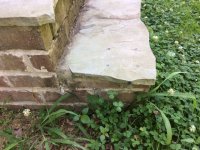Hi guys,
I'm mounting square steel posts on the corners of my front steps for some handrails. The stair tread "cap" is bluestone, with brick underneath. I have no idea how solid the area inside the perimeter brick is. Maybe just rubble. I plan to use regular "red-head" anchors, probably 2-1/2" or 3" long. I have little experience with bluestone and don't know how crack-prone it may be.
The questions; do you think that I can drill these with regular 2-flute carbide percussion masonry bits, or do I need to get spendy and use diamond saws?
Should I plan to to pre-fill the holes with some sort of grout just before I insert the anchors?

I'm mounting square steel posts on the corners of my front steps for some handrails. The stair tread "cap" is bluestone, with brick underneath. I have no idea how solid the area inside the perimeter brick is. Maybe just rubble. I plan to use regular "red-head" anchors, probably 2-1/2" or 3" long. I have little experience with bluestone and don't know how crack-prone it may be.
The questions; do you think that I can drill these with regular 2-flute carbide percussion masonry bits, or do I need to get spendy and use diamond saws?
Should I plan to to pre-fill the holes with some sort of grout just before I insert the anchors?
